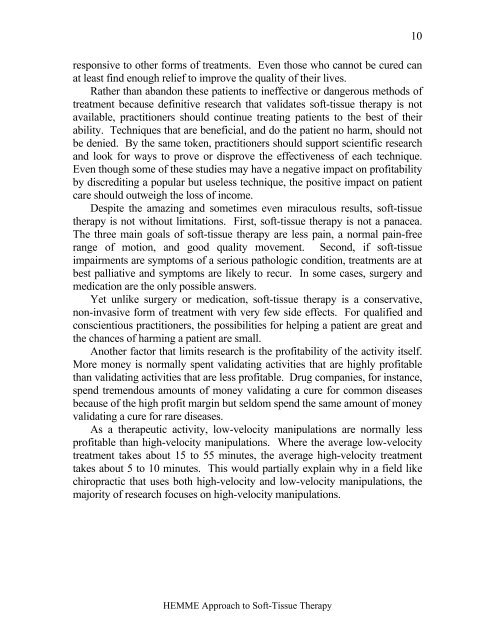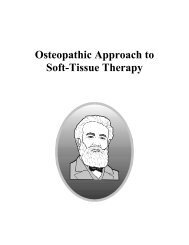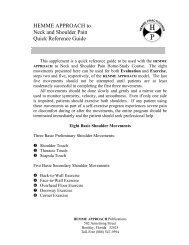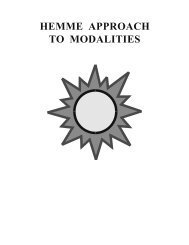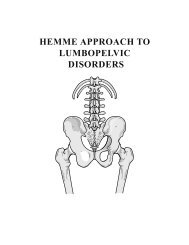HEMME APPROACH TO SOFT-TISSUE THERAPY
HEMME APPROACH TO SOFT-TISSUE THERAPY
HEMME APPROACH TO SOFT-TISSUE THERAPY
Create successful ePaper yourself
Turn your PDF publications into a flip-book with our unique Google optimized e-Paper software.
esponsive to other forms of treatments. Even those who cannot be cured can<br />
at least find enough relief to improve the quality of their lives.<br />
Rather than abandon these patients to ineffective or dangerous methods of<br />
treatment because definitive research that validates soft-tissue therapy is not<br />
available, practitioners should continue treating patients to the best of their<br />
ability. Techniques that are beneficial, and do the patient no harm, should not<br />
be denied. By the same token, practitioners should support scientific research<br />
and look for ways to prove or disprove the effectiveness of each technique.<br />
Even though some of these studies may have a negative impact on profitability<br />
by discrediting a popular but useless technique, the positive impact on patient<br />
care should outweigh the loss of income.<br />
Despite the amazing and sometimes even miraculous results, soft-tissue<br />
therapy is not without limitations. First, soft-tissue therapy is not a panacea.<br />
The three main goals of soft-tissue therapy are less pain, a normal pain-free<br />
range of motion, and good quality movement. Second, if soft-tissue<br />
impairments are symptoms of a serious pathologic condition, treatments are at<br />
best palliative and symptoms are likely to recur. In some cases, surgery and<br />
medication are the only possible answers.<br />
Yet unlike surgery or medication, soft-tissue therapy is a conservative,<br />
non-invasive form of treatment with very few side effects. For qualified and<br />
conscientious practitioners, the possibilities for helping a patient are great and<br />
the chances of harming a patient are small.<br />
Another factor that limits research is the profitability of the activity itself.<br />
More money is normally spent validating activities that are highly profitable<br />
than validating activities that are less profitable. Drug companies, for instance,<br />
spend tremendous amounts of money validating a cure for common diseases<br />
because of the high profit margin but seldom spend the same amount of money<br />
validating a cure for rare diseases.<br />
As a therapeutic activity, low-velocity manipulations are normally less<br />
profitable than high-velocity manipulations. Where the average low-velocity<br />
treatment takes about 15 to 55 minutes, the average high-velocity treatment<br />
takes about 5 to 10 minutes. This would partially explain why in a field like<br />
chiropractic that uses both high-velocity and low-velocity manipulations, the<br />
majority of research focuses on high-velocity manipulations.<br />
10<br />
<strong>HEMME</strong> Approach to Soft-Tissue Therapy


